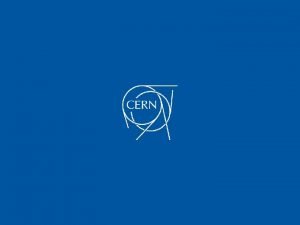Study of the DelayLine Readout for GEM Detectors

- Slides: 1

Study of the Delay-Line Readout for GEM Detectors Yi Zhou*, Cheng Li**, Yongjie Sun , Department of Modern Physics, University of Science and Technology of China * zhouyi@mail. ustc. edu. cn , ** licheng@ustc. edu. cn PSD 8, September 1 -5, Glasgow 3. Calibration (for D 1 model) 1. Introduction Recently, Position Sensitive Detectors (PSD) have opened a new trend in the radiation detection and X-ray imaging, such as the Gas Electron Multiplier (GEM) based detector which has high spatial resolution and stability in intense particle beams. Most of the readout techniques, GEM detector based on Centerof-Gravity readout method, employ large number of amplifiers and shaping electronics for the channel-by-channel readout. To decrease the cost on electronics and keep good spatial resolution, we design a fast delay-line circuit for the GEM detector readout. The delay-line circuit is consist of many discrete LCs (inductor-capacitor). These LC cells connected to individual anode or cathode strips. The localization information is derived from the propagation time of the induced signals traveling along the delay-line and measured directly by current amplifiers at each end of the delay-line. The linearity and time response dependence on the accuracy of time difference, which is determined by the time delay per cell and the distributed parameters of readout PCB. (1). The photograph of delay-line PCB with 96 cells (2). Comparison of simulation and experiment Ø Calibration (test with pulse rate up to 106 Hz) 2. Design (1). Get information from the detector Ø The output signal property of a triple-GEM detector: pulse rise-time: <10 ns, Cut off frequency : <400 MHz (2). The parameters of Delay-Line Simulation : 2. 75 ns/Cell Experiment : 2. 82 ns/Cell Ø Signal properties: Input position: port 1 Ø Cut off frequency: Input position: port 16 Ø Characteristic impedance: Ø Delay time/cell: Simulation (3). Designed parameters of three delay-lines Experiment Simulation Experiment 4. Test (by using X-ray and a mask with 0. 2 mm slot) (4). Simulation program ( 2 D Extractor, Simplore, Matlab-Simulink) GEM Detector & X-ray tube Output Signal of D 1 Output Signal of D 2 Output Signal of D 3 Ø Position resolution (with 0. 15 mm width and 0. 4 mm pitch readout stripes) Ø Electric Circuit Model of GEM Readout Electrode Ø Simulation Program for Delay-line Calibration D 1 : 2. 75 ns/Cell D 2 : 4. 69 ns/cell D 3 : 12. 42 ns/cell Ø D 3 model has a better resolution(σ<100 microns) at the count rate up to 105 Hz. Ø D 1, D 2 are more stable compared with D 3 in high-rate environment. Ø Diagram of Constant Fraction Discriminator (CFD) Ø Diagram of Time-Digital Converter (TDC)

